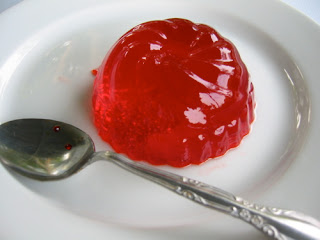Let's start at the very beginning...
Many of you are familiar with at least a part of our family's story of how we became interested in real food and holistic health. It all began with our sweet little Adelaide, who even as a newborn baby had terrible eczema, so bad I often said it felt as if she were wearing a wool sweater. Past the point of normal dry newborn skin, Adelaide's was rough, itchy, red, and often accompanied by open, weepy sores in her sweet chubby rolls. It was heartbreaking to see, and it became an obsession to find the right soap, cream, lotion, balm, anything that would fix my poor little baby and make her skin soft!
We tried everything, from the traditional to the extreme, and nothing seemed to work. Finally I bit the bullet and made an appointment with the dermatologist, who prescribed a topical steroid, and it worked! For a while, at least. We had to be extremely diligent with applying it, multiple times a day, and after some time it seemed almost as if the eczema was fighting back. She would seem clear and smooth for a week or two, and then something would happen to cause a flair up, and it was worse than ever. Of course I know, and realized it then, that there are much worse conditions a child can have than eczema. I was thankful for Adelaide's overall health, as well as that of my other children, but her itchy, uncomfortable skin was a problem, and I wanted to fix it!
At 9 months of age Addy's pediatrician gave us the go-ahead to give her a little dairy. Some cheese or yogurt, he suggested. And this is where things started to change. Addy took one bite of cheddar cheese and was covered in red splotches all over her face and body. I remember that the next day, after the spots had cleared, we put the same bib on her (we may not have cleaned it all the way...oops!) and she broke out again! This was the first time we had ever dealt with a food allergy in a child, and I instantly felt ashamed at my feelings towards "those parents" of kids with allergies. Turns out, they weren't being overdramatic attention hogs, they were just trying to protect their children! And now I was one of them. Looking on packages, asking if dinner at a friend's house had been cooked in butter, cutting down on (but not omitting entirely) the dairy I ate.
This is a long story for a girl who is not yet three years old, so I'll fast forward. We continued with the dermatologist, and saw an allergist who confirmed that Adelaide is allergic to casein, which is the protein found in milk. I noticed that she had some trouble with wheat as well, and later found out that peanuts caused skin issues. Funny thing was, the dermatologist and the allergist both agreed on one thing: the allergies and the eczema were probably not deeply related. Yes, many kids with food allergies also have skin issues, but the relationship between the two was not a causal one. This didn't sit well with me, and I think that is when I really started to do my own research.
Now comes the part where I become the crazy #realfood lady. I started with a blog suggested by a friend,
Mommypotamus. (For the record, this is an amazingly researched blog and Heather Dessinger has become one of my real food heroes.) I started reading about the connection between allergies, skin issues, and nutrition, and continuously came across the same phrase over and over: "Leaky Gut Syndrome." What I learned, in very simple, non-scientific terms, is that the food we eat (or the food our mother eats while she was carrying us in her womb) has an effect on every part of our body. Our gut (digestive system) is where 80% of the body's immune system lives, so poor nutrition can lead to some really messed up immune responses. Leaky gut syndrome occurs when the lining of the gut has not properly healed. Babies are born with their digestive system still immature, but basically, when her's was supposed to close up and start doing it's job (ya know, like digesting milk protein) Adelaide's just didn't. (For a more detailed explanation of Leaky Gut Syndrome, read
this.)
I felt like I had really found something. The "what' of this whole problem was coming into focus...so now, of course, I had to look at the "why." And some of you already know where I'm going with this. When I was pregnant with Adelaide, I was addicted to Diet Coke. I don't say this lightly, this is not a tongue-in-cheek moment. I ate organic veggies and fruits, tried to eat the right kinds of meats and stay away from junk food, but I HAD to have my Diet Coke. Many glasses a day, without fail. (For those of you who love DC, please know that I'm not coming down with my hammer on your occasional treat. This was a nasty habit, and I have since had to turn around and not look back. While I do believe Diet Coke is a harmful substance and that we would all be better without it, I know that it is possible to drink it in moderation and maintain good health.) Having learned what I did about Leaky Gut, as well as the dangers of aspartame, I truly believe that this was the main cause for Adelaide's allergies and eczema. It's been hard, looking at the patches of dry skin on her body and knowing that I caused them, but I feel empowered by that knowledge as well, because I was able to make vastly different choices in my pregnancy with Jude, and I know now that my nutrition is of the utmost importance when it comes to the health of my little growing babies.
It was eye opening to me that bad nutrition could have an effect on so many aspects of our health. Weight problems? Sure! Heart health? No doubt! But food allergies, seasonal allergies, migraines, chronic illness and disease? I had just taken those things for granted! We don't know why they happen, but we can treat the symptoms! If you've had to step out of the room for a moment, come one back. This could mean something for your family too. You see, the chronic illness and annoying allergy issues Americans have been accepting as a way of life are actually caused by something. And that something is poor nutrition. I'm not here to tell you how to feed your family the perfect diet, I certainly don't feed mine perfectly. But if you are experiencing any of these issues, I would encourage you to do some deep investigating to find out if you can get to the true source of the problem. Because the steroids that Adelaide used for much of the first years of her life weren't really solving the problem. She went on more and more intense doses of steroids, spread all over her skin (the largest organ on the body, and very permeable as well!) saw a bit of progress, and never got to the root of her problem. We were treating the symptom, not the cause.
This is where
Well of Life Center comes into the story. The Well is a holistic health center where people who have chronic illnesses come to find healing. I had met our clinician, Megan, at an informational session at a friend's home a few weeks ago. She impressed me with her knowledge, her sweet demeanor, her confessions of skepticism, and her beautiful testimony of faith in Christ. Knowing that The Well was founded by a Christian woman was helpful for us, because things in the holistic health world can get pretty strange and trippy. But Megan herself said that at her first visit to The Well she was reassured by her clinician repeatedly telling her that she was fearfully and wonderfully made by God. That was a breath of fresh air for me.
Today at The Well our lovely clinician, Megan, was able to confirm what I have long suspected. Adelaide's stomach, as well as her kidneys and small and large intestines, are in distress. This is most likely Leaky Gut Syndrome, and was most likely caused by the poor nutrition she received while I was pregnant with her. I could try to explain to you the diagnostic process they used to find this out, but it would really seem even stranger to you than it did to Jesse and I, and it was pretty strange. But I had met Megan, I had heard her own amazing story of healing, I trusted her, I have friends who are going to The Well for treatment and seeing amazing results within days, weeks, and months, so I put aside any skepticism and just listened. And what Megan had to say made so much sense. Adelaide has a LOT of food sensitivities, some of which I already knew about (milk, wheat, peanuts) and some things that I was continuing to feed her and even thought were beneficial (oats, rice, corn). Her diet is going to be pretty limited for the next weeks and months, but Megan assured me that the goal is to get her body to a place where she is able to eat all of those things! Before today I could scarcely imagine a time when Adelaide could have cheese on her eggplant parmesan, and now we have a plan in place to get her there!
The plan for now is to keep Addy on a pretty restrictive, but nutrient dense diet. She can eat fruit, which was a relief, because sugar is out of the question. Honey was one of the few foods she had no reaction to, which made her a very happy girl. She can eat meat, veggies, beans, almonds, wild rice, and quinoa. She is also taking a supplement to support her digestion, not a synthetic vitamin but a real food supplement that is targeted specifically to her needs. We'll go back in a week, and they'll continue to give their time and energy to helping us to heal our sweet little girl. It's not cheap, and medical insurance doesn't cover our visits there. But there were moments that I saw today at The Well that are truly worth the sacrifice it will take to continue there. Adelaide giggling on the table as Miss Megan tickled her belly, and told her that it wasn't working right. Addy making a friend in the waiting room, another two and a half year old girl named Adelaide, while her mother and I spoke to each other. Looking at the book shelf in the waiting room and seeing a Bible among the other literature. Megan holding Adelaide in her lap and giving her kisses on her cheek, because she really cares about our little girl already. Megan reassuring me, when I spoke about my poor nutrition being the cause of this problem, and reminding me not to bring up old things, because God's grace has covered it. These moments gave me hope, and I look forward to seeing how our visits to The Well and following their guidance could change Adelaide's life. I've been praying for this for a long time, and today God showed me a glimpse of His plan. I hope that we will see healing in Adelaide's body, and I will continue to share about our experiences with The Well.
Thanks for listening.
















